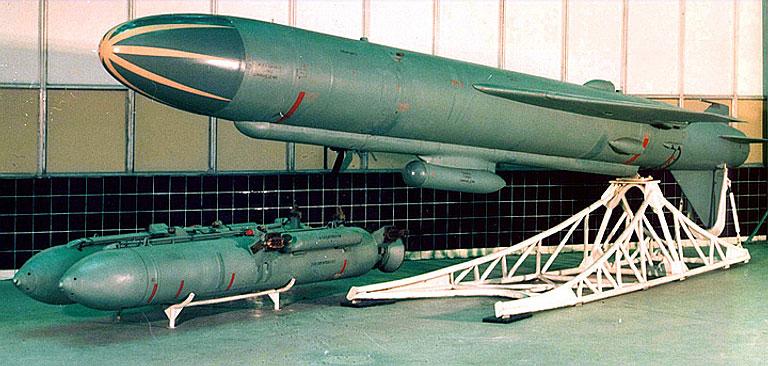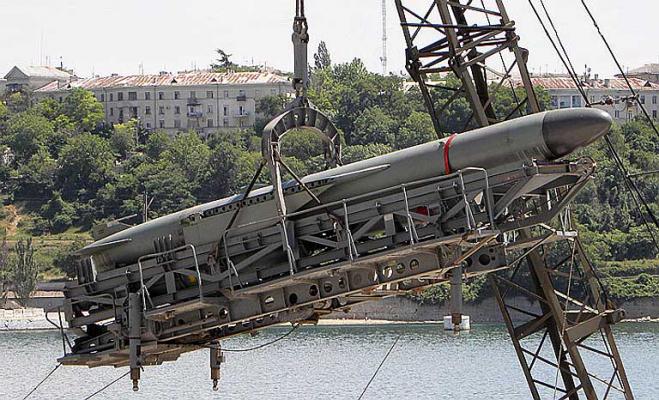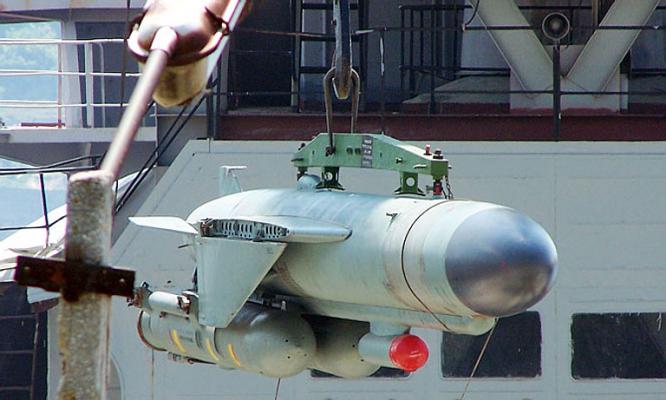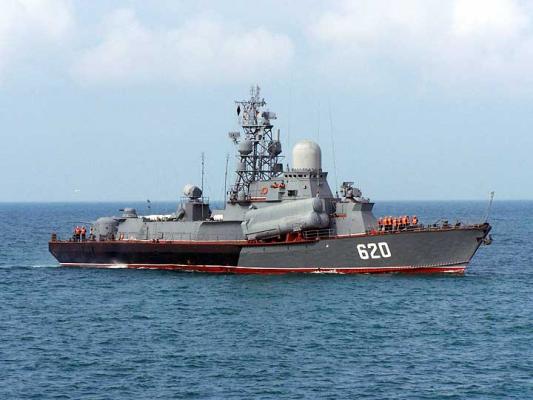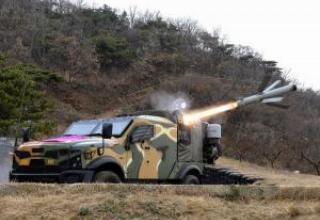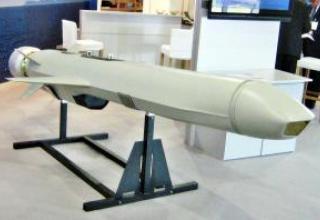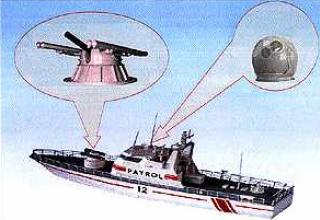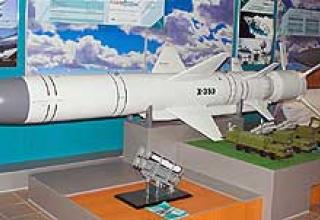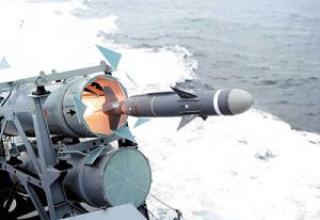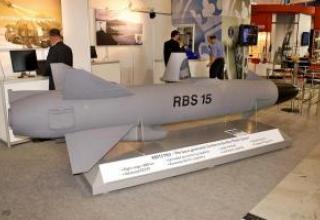On February 28, 1963 the Decree of the Council of Ministers of the USSR N 250-89 on the development of a unified anti-ship missile designed for use both from submarines in an underwater position and from surface ships was issued. OKB-52 was appointed as the head designer of the complex designated P-120 "Malachite". The new complex was a development of P-70 "Amethyst" anti-ship complex and was intended, in particular, to replace P-70 on Project 670A submarines.
The "Malakhita" evanproject was completed in September 1963, and the conceptual design was completed in February 1964. At the beginning of 1968 Plant N 301 named after Lavochkin produced the first missile samples.
The P-120 missile was adopted for service on 17 March 1972 for the small surface missile ships of the 1234 project and on 21 November 1973 for the 670M project submarines. The Malachite missile system was also planned to arm project 686 (705A) nuclear-powered submarines, which were under development in the mid-1960s. However, this development was not continued. Mass production of the P-120 was launched at Machine-Building Plant No 47 (Orenburg).
The "Ovod" ships (project 1234) are intended for protection of marine communications, protection of convoys, fighting against enemy surface ships in coastal areas. Tactical and technical design assignment was given to the Central Design Bureau-5 (later the Central Design Bureau "Almaz") in 1965. I.P. Pegov became the Chief Designer of the project. The standard displacement of the 1234 project ship was 580 tons, and the total displacement was about 670 tons. The full speed was 35 knots. The "Ovod" was equipped with two constructed launchers of the complex P-120 "Malachite" with a radar system of target designation "Titanit", which was adopted in service in 1970. The complex "Titanit" had two ways to detect targets: the first by radar at a distance of 40 km, the second - zagorizon passive radiation of enemy radio equipment. According to the project, the P-120 missile with the MRK could be launched at sea waves of up to 5 points inclusive and at ship speeds of up to 24 knots. A logical continuation of the MRK "Ovod" was the project 12341. The main differences of this project are the increase of the main artillery caliber from 57 mm to 76 mm, additional installation of one 30 mm AK-630 art complex on the ship, as well as new radar and electronic equipment.
Works on creation of the modernized 670M PLARK, which received the Chaika cipher, began in the late 1960s in Gorky SKB-112. The Chief Designer of the boat was originally V.P. Vorobyov, after whose death the work was headed by A.G. Leshchev. The 670M project SSB was equipped with eight launchers of the P-120 complex. Construction of project 670M ships was carried out in Gorky at the shipyard "Krasnoye Sormovo". A total of 670M project boats were built, all of them have now been withdrawn from the Navy after the end of their operational life (25 years).
In 1973, a small hydrofoil missile ship MRK-5 (project 1240) was launched on the Leningrad Primorsky Shipyard. The ship went on trial in 1976 and went into service on 30.12.1977. The displacement of the ship is 426 tons, the standard is 342 tons. Full stroke speed of 57 knots, range of 50 knots stroke of 700 miles. Armament - 4 PCR P-120 "Malachite", 1 SAM system "Osa-M", 1x6 30 mm AU AK-630M. The MRK-5 had high speed and good navigability, but turned out to be capricious in operation, and its wing system is not reliable enough. After completing the testing program in 1979. MRK-5 arrived in Sevastopol and was included in the 116th Division TKA 41st Separate Brigade RKA. In 1990 he was expelled from the Navy.
Modernization of the P-120 missile began in late 1975 and continued until mid-1980. The reliability of the onboard control system was increased, the sensitivity, interference immunity and selectivity of the homing head was significantly increased. The time of development of commands in the ship's control system "Danube-1234" and data entry into the missile control system was shortened. The design of the three-container launchers and the loading device has been improved.
NATO SS-N-9 "Siren" designation
Composition:
Solid fuel rocket P-120 (see diagram) was made according to the normal aerodynamic scheme, had a folding wing and externally repeated rocket P-70. P-120 (4K85) had a launching mass of 3180 kg and carried a shrapnel-phase warhead weighing 840 kg or a nuclear warhead with a capacity of 200 kt. The maximum range of the P-120 (4K85) was 150 km and its flight speed was equal to M=1.
The principal difference of "Malakhit" was the universal launch vehicle, which provided an opportunity to launch from submarines as well as from surface ships. It consisted of two solid propellant launch engines and two additional submarine propellant engines installed on missiles used from the submarine.
The solid propellant marching engine 4D-85 developed by KB-2 of Aircraft Plant ¹ 81 headed by I.Kartukov had the weight of 627±15 kg in the unloaded state and 2776±25 kg in the outfit. The traction in acceleration mode was from 1200 to 1600 kg, on the marching section 600-950 kg. The full operating time of the marching engine was 385s at ambient temperature -2°C and 360s at temperature +32°C. The engine was powered by LTS-2KF fuel (instead of LTS-2KM at P-70 missile), which gave a long black plume behind the missile, which demasked the submarine and the missile.
Compared to the Amethyst, the onboard control system of the APLI-5 created at the Research Institute-10 (currently NPO Altair, Moscow) differed significantly. In the P-120 missile the selectivity of the homing radar system was significantly improved and its interference immunity was increased. Before the launch, based on the tactical situation, a target acquisition sector was established. In addition to the active radar homing head, the PKR also received a so-called "finishing block" - an infrared sensor "Bustard", installed in the container on the external suspension and "safety" radar at the end of the trajectory. Booster P-120 missile better provided guidance to the main target in the ship's warrant.
On the nuclear-powered submarines of the 670M project P-120 missiles were placed in eight SM-156 launchers outside a solid hull, inclined at an angle of about 32° and combined with the Rubicon hydroacoustic complex, which has a detection range of more than 150 km. Thus, the submarine was able to use the Malachite system at full range, without external target designation. Automated prelaunch preparation of the missile volley was provided by the Danube-670M based on digital computer. SLCM checked all eight PCRs simultaneously and ensured their launch. Manual operations to prepare and launch the missile were extremely shortened and automated. Compared to the Amethyst complex (with analogue equipment), the pre-launch preparation time was reduced by 1.3 times. To ensure reliable stabilization of the submarine during missile launch, automatic software control of the submarine depth and differential was introduced, which was carried out using the rudders and negative buoyancy replacement system.
The SM-156 launcher (see layout diagram) was developed in the Leningrad CKB-34 (at present the Special Machine Building Design Bureau) and represented a cylindrical design with a spherical bottom and a folding spherical cap. The missile was launched from an underwater position at a depth of 50m from a container pre-filled with water ("wet start").
Submarine launch vehicles (project numbers) 670M, 686 (705A), 688
Characteristics:
| Length, m | 9,15 (8,84-9,0) |
| Wingspan, m | 2,5 |
| Hull diameter, m | 0,8 |
| Start weight, kg | 3180 |
| Speed, M. | 0.9-1 |
| Range of fire, km | 15-110 (120-150) |
| Flight altitude, m march. | 60 |
Testing:
The first stage of flight and design tests of P-120 began in September 1968 at the "Sand Beam" range and was carried out from the shore launcher in an autonomous version, that is, the rocket had only an autopilot and a radio altimeter. The launcher was mounted on the battlefield of the range in the village of Chernomorsk. The first launch was held on September 20. The planned range of fire was 100-120 km. However, due to the autopilot's failure the rocket immediately after the launch started to rotate around its axis and fell into the sea on the 15th second of the flight. The second launch took place on December 13, 1968. The rocket flew about 85km for 415s. The launch program as a whole was completed, but the speed was low - only 770 km / h instead of the estimated 1200 km / h. The third launch was made on February 26, 1969. This time the rocket flew 106 km for 411s, that is the speed reached about 1000 km/h. The launch program was fulfilled, but on the 70th second of the flight the onboard telemetry station was out of order.
The second stage of the flight and design tests was conducted both at the Sand Beam range and from the diving stand in Balaklava. From June 23 to October 10, 1969 four fully equipped missiles were launched from the ground launcher. The rockets were launched at the target. The first launch took place on June 23. The missile did not have a heat homing head (HHV). The specified range of fire was 40 km. Due to failure of the missile did not reach the target about 200m and fell into the sea. Flight time - 131 s. The next launch was made on August 8. Due to failure of the magnetron RSG target was not detected and the rocket was exploded after flying 65.8 km for 217 seconds. The rocket launched on September 10 already had on board the TGS, but it was not activated. The target range was 40 km. The missile hit the target network at an altitude of 6m from the waterline and 25m to the right of the target center. The flight time was 137.6 seconds. On October 8, 1969 the missile was launched from the working TGS on the target with the installed thermal simulator "Balancer". The target range was 40 km. The missile hit the target at an altitude of 11m from the waterline and 13m to the right of the target center.
For underwater launches, the Central Design Bureau-16 developed a project to convert the PSA submersible stand, which was previously used to launch the Amethyst rocket, into the PSP-120 stand. The same Central Design Bureau-16 was tasked to convert the 613AD submarine into the 613P-120 project for submarine launches of Malachite missiles. However, the Central Design Bureau's work showed that due to low displacement, the Project 613P-120 submarine will be out of control at the moment of launch, so the developers proposed to use the Project 611 submarine with high displacement for pilot launches. The Navy agreed with the conclusion of the Design Bureau and agreed to allocate the submarine of project AB611 for re-equipment. However, the refurbishment was not carried out. GCS and the Navy decided to conduct flight and development tests from the Project 670M combat submarine. The re-equipment of the PSA stand under project PSP-120 at Plant 444 was slow due to the delay of the main designers and manufacturers of the complex parts supply. Only in August 1968 the main assembly works were completed and the stand was moved to the technical position 99375 at Balaklava, where it continued to be re-equipped. After mooring tests and trial dives on December 28, 1968 the act of readiness of the submersible stand PSP-120 was signed. From July 17 to October 20, 1969 3 Malachite rockets were launched from PSP-120 in the Balaklava area. Three launches confirmed steady and stable passage of the missile through all sections of the trajectory: container of the stand, underwater trajectory, transition from water to air trajectory and air trajectory.
The head ship of the project 1234 MRK-3 (plant № 51, 24 April 1970 was named "The Storm") was laid on January 13, 1967 at the slipway of the Leningrad Primorsky Plant. On October 18, 1968 it was launched. With the beginning of navigation in 1969 the ship was transferred to the Black Sea by inland waterways. The first launch with the MRK-3 was made on March 27, 1970 at a distance of 40 km on a target equipped with a thermal imitator "Balancer". The speed of the MRK at the time of launch was 24 knots. Due to the failure of the RGS equipment the target was not captured, the rocket flew past and at the 198th second self-liquidated, flying 58.6 km The next launch was held on May 28. Shooting was carried out without a heat homing head, as by that time there was a need for its special tests. The target range was 40 km. The speed of the MRK - 24 knots. Direct hit was achieved at the height of 6.5 m from the waterline and 8.8 m to the right of the target center. The missile was driven behind the target at 105 m. Flight time was 135.4 s. The flight time was 135.4 s. This launch completed the flight and design testing stage.
Then the joint tests began. The launches were conducted with the MRK "Storm". The first launch under the joint testing program took place on June 10, 1970. The TGS on the rocket was disabled. The specified range was 40 km and the speed of the missile was 24 knots. The missile hit the target network at an altitude of 6.2m from the waterline and the right center of the target at 31.5m. The flight time was 136 seconds. The next launch was held on June 26 at a range of 80 km. The speed of the MRK was still 24 knots. Due to "non-permissible" fuel in the marching engine there was a sharp increase in pressure in the combustion chamber: the rocket exploded at 41.4 seconds of flight, flying only 9.2 km. On July 31, the rocket was launched under the same conditions and with the same mission. Due to the malfunction of the TGS in flight, the rocket did not hit the target and was brought to 300 m behind the target at 252.3 seconds of flight. On August 19, the "Storm" first fired at a group target. There were two targets at a distance of 80 km from the MRK. The MRK was moving at a speed of 24 knots. We achieved a direct hit on the target - right into the counter of the thermal imitator "Balancer". The missile hit the rack and was driven 80 m away from the target. The flight time was 252.8 seconds. It's worth making a little comment here. RGS "Malakhita" could not detect targets at a distance of 80 km, and TGS detected thermal radiation, God forbid, at a distance of 10-12 km. So how did the missiles hit the targets? The fact is that the commanders of the carrier ship in the tests knew the location of targets and very accurately withstand the bearing of fire, so that the missiles could not fail to reach the target area. And in the real world, the target designation should have been made with Tu-95RC reconnaissance aircraft, as well as with other aircraft, helicopters and ships. September 10, 1970 the first salvo fire took place. The "Storm" fired at once two missiles (№ 0411 and № 504) on two targets at a range of 80 km. The speed of the MRK was 24 knots, the interval between launches was 5 s. "The Storm" fired two missiles at two targets at a range of 80 km. Rocket number 0411 due to a malfunction in the control system was driven 160m in front of the target and hit the target with numerous fragments. The flight time was 255.6s. The same thing happened to the second rocket (No. 504) and it was brought to the 253.6 seconds of flight without reaching the same target at 130m. On October 10 the "Storm" MRK was launched from the target at a range of only 15 km. The speed of the MRK was the same. Due to TGS failure the missile fell 10km from the launch site to the 40.9 second of the flight. On December 14, 1970 it was launched with the same mission and under the same conditions. Due to the failure of the RSG occurred shortly before the target at 4.8 km The rocket was driven by the 42.5 second of flight.
In spring 1970, the second ship of the 1234 MRK-7 project was transferred from Leningrad to Feodosia for inland water systems. On 24 April 1970 it was named "Breeze". From December 1970 onwards the second ship of the project 1234 MRK-7 was transferred from Leningrad to Feodosia on 24 April 1970 under the name "Breeze". "Malachite" was already tested on the "Breeze" (Commander Captain 3 rank A.I. Bondarenko). The first launch of P-120 from "Breeze" took place on December 29, 1970. Shooting was carried out at a distance of 100 km at a speed of MRK 22 knots. A direct hit was achieved at an altitude of 9 m from the waterline and 1.5 m to the right of the target centre. Flight time - 321.4 sec. The ship was launched on January 23, 1971 at a speed of 24 knots at a range of 30 km. Direct hit on board the target at 3m above the waterline at 105.8 seconds of flight was achieved.
The next launch was held on March 5, 1971 from the "Storm" on the target at a range of 100 km. The MRK was going at a speed of 12 knots. The missile hit the target network at an altitude of 5 m from the waterline and 25.5 m to the right of the target centre. At the same time RGS was working, as the TGS was out of action. The flight time was 336 seconds. March 10, "Storm" again fired at the target under the same conditions. The missile hit the net at an altitude of 13.5 m from the waterline and 2.5 m to the right of the target center. The flight time was 331.8 seconds. - On April 10, the "Storm" fired on a moving target at the Ave. 183-C with the Cyclone heat simulator at a distance of 20 km. The speed of the ship was 17.5 knots, and the target was 25 knots. The missile, unlike previous launches, was not an inert one, but a combat unit. For an unexplained reason, the missile exploded 80-100m from the target and hit it with a large number of fragments. On April 16, 1971 the "Storm" fired on the target at a distance of 15 km. The speed of the MRK was 17 knots. Because of the non-standard separation of the starting engine the rocket was driven 1.8 km from the MRK at 13.1 second of the flight. June 2 "Storm" fired at the target at a distance of 15 km. The speed of the ship was 22 knots. Due to the malfunction of TGS, the missile fell into the water, not reaching the target of 35m, the target was hit by shrapnel. On June 39, the "Storm" gave three missile volleys (rockets ¹ 0301, ¹ 507, and ¹ 1101) on two targets with a thermal imitator "Balansir", etc. The ship was hit by shrapnel. 183-C without the Cyclone thermal imitator - at a distance of 100 km. The targets were 600m from each other. The interval between missile launches was 5s. The MRK went at a speed of 23 knots. Rocket number 0301 hit the target at the base of the left column of the thermal imitator above the deck by 1.5 m. The flight time was 315 seconds. The second rocket (No.507) hit the "rose" of corner reflectors of the target pr. 183-C at the 311th second of the flight, that is, rocket number 507 did not "disassemble" and preferred the aircraft carrier ship security. But the third rocket (¹ 1101) got where it was necessary, that is in the target at 4m above the waterline and at 15m to the right from the center of the target. The flight time was 315.9c. This was the end of the tests of the Malachite complex for arming the MRK 1234 project.
Sources:
- Александр Широкорад "Огненный меч Российского флота" 2004 год.
- П-120 "Малахит" /http://flot.sevastopol.info/
- П-120 "Малахит" крылатая противокорабельная ракета /http://www.testpilots.ru/
- ОАО "Конструкторское бюро специального машиностроения "60 лет созидательного труда" СПб,2005 год.
